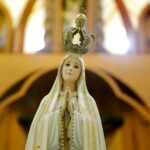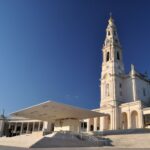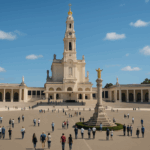In the heart of Portugal lies one of the most captivating spiritual stories of the 20th century—a series of heavenly apparitions that forever changed the quiet rural town of Fátima. What began as a simple encounter between three shepherd children and a radiant lady in 1917 would go on to inspire millions, stir controversy, and intrigue both faithful believers and skeptical historians. At the center of this story are the Three Secrets of Fátima—prophetic revelations given to the children by the Virgin Mary that would only be fully revealed to the world decades later.
To this day, the secrets continue to spark fascination. What did the children see? Why were some details hidden for so long? And how have these revelations shaped the Catholic faith and global history?
This is the story of the Three Secrets of Fátima—their origins, their meaning, and the profound impact they’ve had on the world.
The Setting: Portugal in 1917
In 1917, Portugal was a nation in turmoil. The First World War raged on, and the country itself was under the grip of political unrest following the 1910 Republican revolution, which had established an anticlerical government. The Catholic Church faced hostility, and religious expression was often suppressed.
Against this tense backdrop, in the small hamlet of Aljustrel near the town of Fátima, three shepherd children—Lucia dos Santos, aged 10, and her cousins Francisco and Jacinta Marto, aged 9 and 7—tended their family’s sheep. Life was simple, rural, and deeply rooted in faith, even amid political challenges.
It was here, in the Cova da Iria fields, that the Virgin Mary is said to have appeared to the children six times between May and October 1917. Each apparition drew more attention, and by the final visit in October—witnessed by tens of thousands—the story had spread far beyond Portugal’s borders.
The Day of the Secrets
The apparitions followed a monthly rhythm, each bringing messages of prayer, penance, and conversion. But on July 13th, 1917, during the third apparition, something extraordinary happened: the Virgin Mary shared with the children three distinct secrets.
Sister Lucia, who later became a Carmelite nun, would eventually record these secrets in writing, but at the time, the children kept them hidden—even from family members. Only decades later would the world learn the full content of what they had seen and heard.
The First Secret – A Vision of Hell
The first secret was a vision so vivid and terrifying that the children were left trembling. Lucia later described it in her memoirs:
“We saw a great sea of fire… in which were demons and souls, in human form, like transparent burning embers, all blackened or burnished bronze, floating about in the conflagration, now raised into the air by the flames that issued from within themselves together with great clouds of smoke.”
The children saw grotesque, demonic figures and souls writhing in agony, crying out in despair. The Virgin Mary told them this was the fate of sinners who did not repent and urged them to pray the Rosary daily to save souls from damnation.
For believers, this first secret underscored the urgency of personal conversion and prayer, while for skeptics, it was a disturbing glimpse into the psychological impact of religious imagery on children. Either way, it remains one of the most powerful descriptions of hell in modern religious history.
The Second Secret – Prophecy of War and the Spread of Communism
The second secret was both a prophecy and a call to action. The Virgin Mary warned that the First World War, then in its final year, would soon end. But she also foretold that another, even more devastating war would break out if humanity did not turn back to God:
“If men do not desist from offending God, a worse one will begin during the Pontificate of Pius XI.”
This prophecy would later be connected to the outbreak of the Second World War in 1939. The Virgin Mary also spoke of the spread of Russia’s “errors” throughout the world—understood by many to mean atheistic communism—and requested the consecration of Russia to her Immaculate Heart.
Failure to heed this request, she warned, would lead to the persecution of the Church, suffering for the faithful, and the martyrdom of many.
Historically, this second secret became a focal point for discussions about the role of the Catholic Church in global geopolitics. Throughout the 20th century, popes made various acts of consecration, culminating in Pope John Paul II’s 1984 consecration of the world, which many believe fulfilled Our Lady’s request.
The Third Secret – The Vision of the Martyred Pope
The third secret was perhaps the most mysterious of all—and the most controversial. While the first two secrets were revealed to the public in the 1940s, the third was kept sealed in the Vatican archives for decades. Sister Lucia wrote it down in 1944 and delivered it to the Vatican with instructions that it could be revealed no earlier than 1960, by which time, she said, it would be “clearer.”
However, when 1960 came, the Vatican announced that the secret would remain undisclosed to avoid “sensationalism” that could harm the Church. This decision fueled endless speculation—was it a prophecy of global catastrophe, a warning of apostasy, or even a prediction of the end of the world?
It wasn’t until May 13, 2000, under Pope John Paul II, that the Vatican finally published the text. The vision described a “bishop dressed in white” walking through a ruined city, stepping over bodies of the dead, before being killed by soldiers alongside priests, religious, and lay faithful. The scene ended with angels collecting the blood of martyrs to water the souls on their way to God.
The Vatican interpreted this as a symbolic depiction of the Church’s suffering in the 20th century, pointing in particular to the assassination attempt on John Paul II in 1981—a date that coincided with the anniversary of the first apparition of Fátima. The Pope himself credited Our Lady of Fátima with saving his life, famously placing the bullet from the attack in her crown at the Sanctuary in Portugal.
Interpretations and Controversies
The Three Secrets of Fátima have never been free of debate. Some critics question the authenticity of the visions, suggesting they were influenced by the children’s Catholic upbringing and the political climate of the time. Others argue that the Vatican’s interpretation of the third secret was incomplete, believing there may still be undisclosed elements related to a crisis of faith within the Church.
For devout Catholics, however, the secrets are a timeless call to prayer, repentance, and devotion to the Immaculate Heart of Mary. They see in them a prophetic road map—warning of dangers, but also promising God’s ultimate victory.
The Secrets’ Global Impact
The story of Fátima spread rapidly after 1917, aided by the testimonies of thousands who claimed to witness the famous “Miracle of the Sun” during the final apparition. Over the decades, Fátima has become one of the most important Marian shrines in the world, attracting millions of pilgrims annually.
The messages of the secrets—particularly the emphasis on prayer for peace—have inspired movements, papal visits, and acts of consecration. They’ve also crossed denominational boundaries, with many non-Catholics visiting Fátima out of curiosity or a sense of shared spirituality.
A Place Where Heaven Touched Earth
Visiting Fátima today is to walk in the footsteps of history. The Chapel of the Apparitions marks the exact spot where the Virgin Mary is said to have appeared. The Sanctuary of Our Lady of Fátima, with its basilicas and vast esplanade, stands as a testament to the enduring power of the message given in 1917.
One Portugal Magik Private Tours guest from Chicago described it perfectly:
“I had read about the Three Secrets all my life, but standing there where it happened brought an entirely new depth to it. The air feels different—it’s as if the weight of a century of prayer still lingers.”
Continuing the Legacy
Whether you approach the Three Secrets of Fátima as a believer, a historian, or simply a traveler in search of extraordinary stories, there’s no denying their lasting influence. They have shaped Catholic thought, inspired millions to live lives of deeper faith, and served as a powerful reminder of the fragility of peace.
The message remains as relevant today as it was in 1917: pray, repent, and strive for a world rooted in compassion and moral truth.
Explore the Story with Portugal Magik Private Tours
For those who wish to delve into the mystery of the Three Secrets, Portugal Magik Private Tours offers curated itineraries that bring the story to life. Traveling in comfort in a luxury Mercedes-Benz with an English-speaking driver-guide, you’ll visit the key sites connected to the apparitions, from the Cova da Iria to the humble homes of the visionaries in Aljustrel.
Our most requested Fátima experiences include:
-
A full-day pilgrimage tour of Fátima and surrounding historical sites
-
Multi-day faith heritage tours across Portugal and Spain
-
Private custom itineraries tailored to your spiritual or cultural interests
Contact us today to plan your journey:
Luxury Redefined with Portugal Magik
For over 14 years, Portugal Magik Private Tours has been the first choice of discerning travelers who seek to explore Portugal in style. Our guests travel in Mercedes-Benz vehicles, accompanied by professional English-speaking driver-guides who bring every region to life with insider knowledge.
Most travelers choose multi-day private tours of 7–12 days, combining Lisbon, Porto, the Douro Valley, Alentejo, and Algarve into one seamless journey. With the full support of our Portugal Magik Ambassadors™, every itinerary is curated around your passions and preferences.
- Explore our bestseller tours: https://portugal-magik.com/multi-day-tours/
- Top Transfers & Driver + Vehicle At Your Service: https://portugal-magik.com/driver-vehicle-hire/
- Best Private Day Tours Around Lisbon: https://portugal-magik.com/private-day-tours/
- Read Top Guests Reviews: https://portugal-magik.com/reviews/
- Contact Us: https://portugal-magik.com/contact/
Fill in the form below to request your personalized itinerary. Experience Portugal’s timeless beauty and refined culture — always at your pace, your way.







